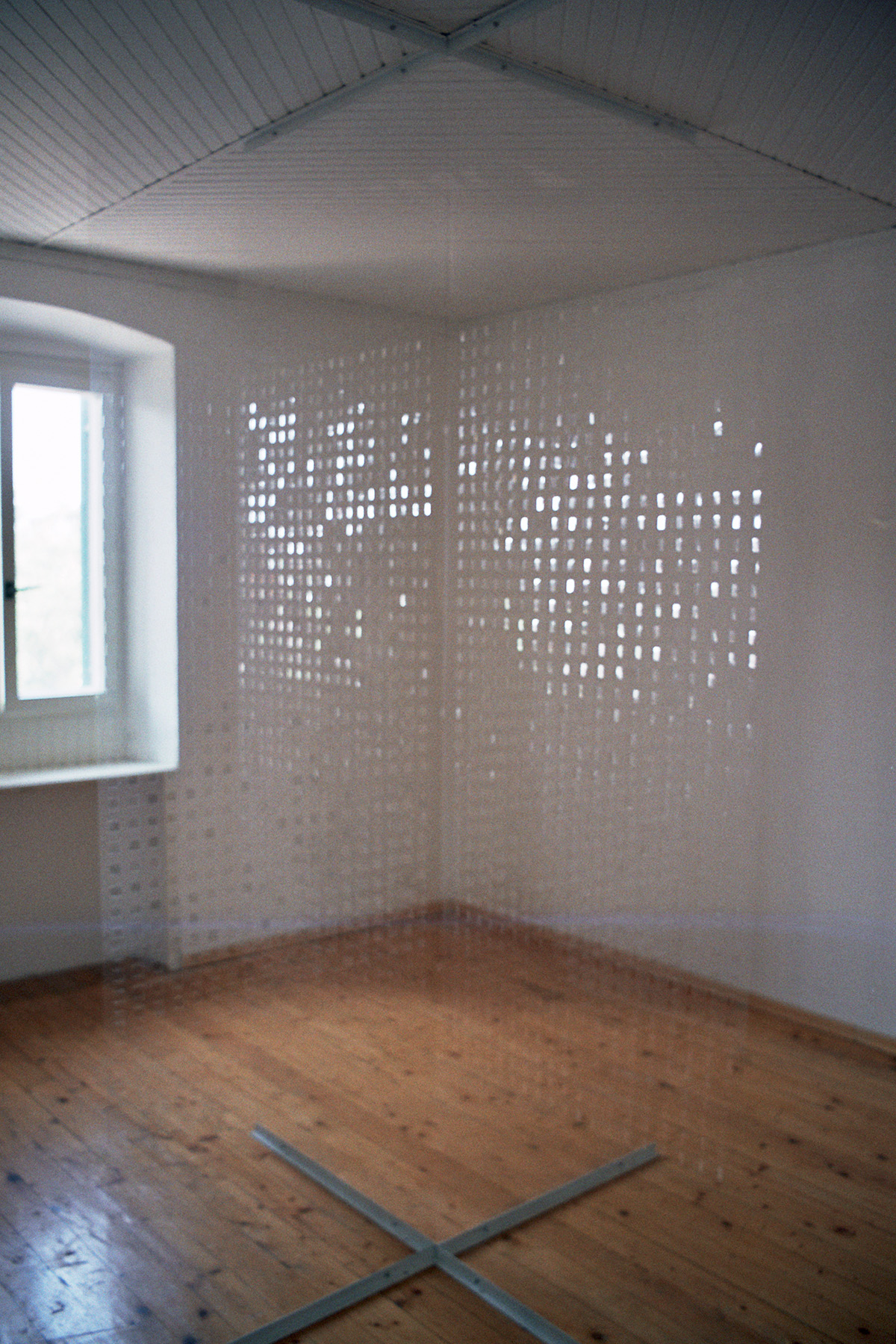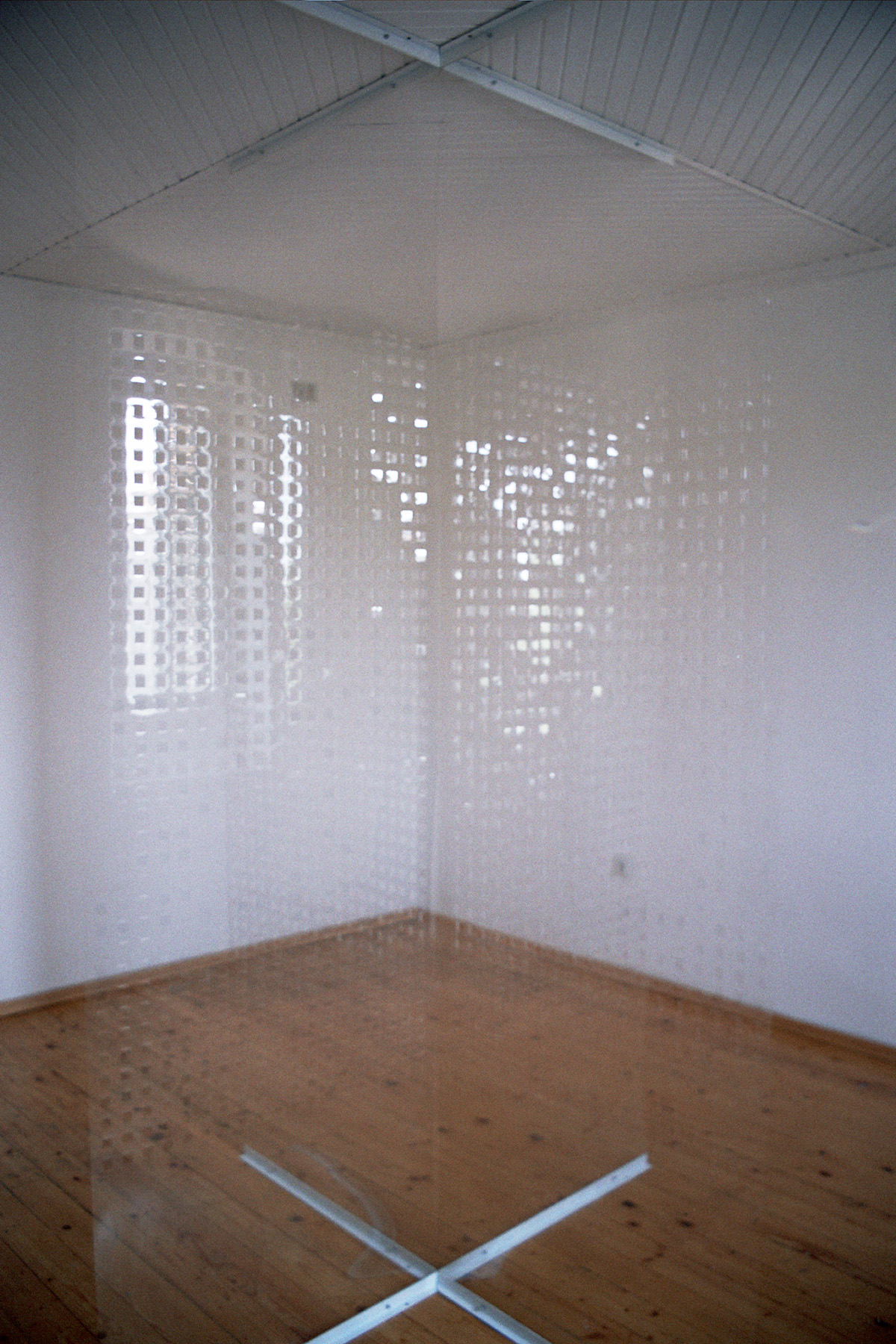Tocke vremena / Points of time
2003. Metal construction, transparent glossy foil. 3 x 2 x 2 m.
Installation view: Ivana Franke, Spots of Time, Marino Cettina Gallery, Umag
Points of Time by Iva Radmila Janković (in Ivana Franke: Points of Time. Edited by Dezi Cettina. Exhibition Booklet. Marino Cettina Gallery, Umag, 2003)
The gallery in this case is not solely a neuter institutional framework to the work of art, but it also becomes an active space.The reality of the room itself becomes the subject as well as the gaze of the observer moving inside the exhibition space left, right, around, halting from time to time and wondering: what he can (not) see?
By articulating the exhibition room by discrete, yet complete interventions utilizing most often transparent and disposable materials, Franke’s creative act is directed towards establishing the conditions for a slowed down perception - comprehension and raising the consciousness of the process of perception proper. In the circumstances when our perception can not be integrated into the linear optical system, it counts entirely on the participation of the observer’s subjectivity, the autonomy of his look having origin in his body.
Inside the room transparent sheets are set up illuminated by daily light. Their invisible role consists in making the expansion of light visible. The grid or screen, an abstract geometric system sometimes employed by Ivana Franke in her experimental inventory, breaks the integrity of the image reflected on it into regular patterns. By decomposing the image on the grid, on the perceptive network, time decelerates segments; the shift of reflection indicates the physical laws of the reflection of light in their antropomorphic relativity.
However, in this instance the situation is somewhat different. On the architecture of the transparent sheets the grid appears in the negative, in other words all its elements are cut from three sides into the sheet. What we notice is a dynamic sequence of reflections. It depends on the way the light falls with regard to the position of the observer and the angle of the sheet, that the “little window” can be read as a hole, flash, or double reflection. The entire situation leads to a slow circular movement, with flashes appearing and disappearing.
In this work the author raises the question:where is the space and what do we experience as a space,where is inside and where outside? How and to what extent do they overlap, namely, in what relation is our mental and physical space? The answer can be partly found in endophysical explanations which claim that the objective reality is just the interior side of the external world, seeing that the endophysical doctrine explains the world as an entity depending on the viewer. The world as an interface. The interface as a momentary condition of things, as a relation of interdependence between the observer’s inner dynamics and the rest of the world. The transparent membrane of plastic sheets behaves too as an interface, disturbing the security of the oculocentically perceived reality, introducing unplanned interstices, refocusing the light to mark the points of time and thus reveal the momentary state of things. (2)
We shall continue with her questions: Isn’t that which we call space only our subjective experience of the space depending on our mental system? For instance: the bee can see lines on the flower, but I can not, since it possesses the ability of seeing ultraviolet waves. “By way of association, this last claim makes us suspicious, permeating us with the sense of insecurity in moving inside the existing but invisible realities which evade our (subjective) perceptions.
The meaning which continues and terminates the critical project of modernity, which raised the issue of the alternative understanding of temporality, has been pursued through the present day artistic practices which no longer offer utopistic support for the teleology of progress, backed up by the Constructivist representatives who explored the laws of the visible world, instead intuitive processes are employed to raise awareness of the co-existence of heterogenious spaces and time.
1 Endophysics of Our Rainbow World, Otto E.Rossler and Peter Weibl , Olafur Eliasson: Surroundings Surrounded, Essays on Space and Science, Edited by Peter Weibel , The MIT Press,


